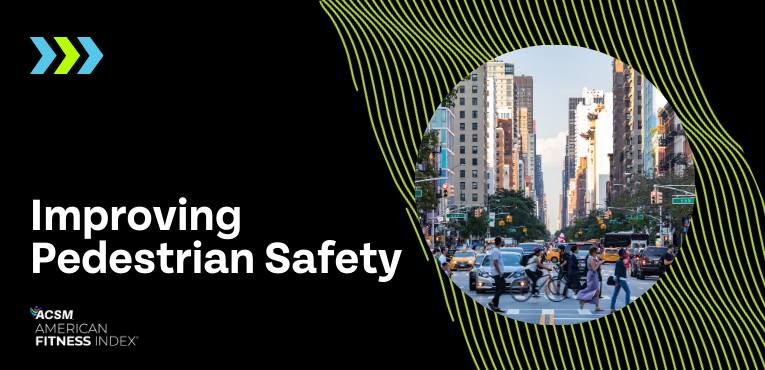|
Aug.
19, 2024

Pedestrian deaths in the United States are declining, but there is still a long way to go to protect the safety of those who are walking, rolling and cycling in American cities.
In 2023, 7,318 pedestrian fatalities occurred in the U.S., a 5.4% decrease from 2022, which saw the highest number of pedestrian deaths in four decades, according to a report from the Governors Highway Safety Association. Although improvements have been made, pedestrian fatalities are still 14.1% higher than pre-pandemic levels (2019 and earlier).
The ACSM American Fitness Index monitors pedestrian fatalities in the 100 most-populous U.S. cities. The average for all cities monitored is 3.2 deaths per 100,000 residents. The cities with the lowest rate of pedestrian fatalities are:
- Irvine, CA (0)
- Lincoln, NE (0.3)
- Plano, TX (0.3)
- North Las Vegas, NV (0.4)
- Garland, TX (0.4)
- Arlington, VA (0.4)
- Henderson, NV (0.6)
- Gilbert, AZ (0.7)
- Reno, NV (0.7)
- Omaha, NE (0.8)
While some cities are excelling in pedestrian safety, others are tragically failing. The cities with the highest rate of pedestrian fatalities are:
- Memphis, TN (8.8)
- Albuquerque, NM (8.7)
- St. Louis, MO (7.5)
- Tucson, AZ (7.2)
- Detroit, MI (7.0)
- Tampa, FL (6.9)
- Orlando, FL (6.8)
- Atlanta, GA (6.5)
- Miami, FL (6.1)
- Phoenix, AZ (6.0)
“A decline in pedestrian deaths offers hope that after years of rising fatalities a new trend is starting,” said GHSA Chief Executive Officer Jonathan Adkins. “Each death is tragic and preventable. We know how to improve safety for people walking – more infrastructure, vehicles designed to protect people walking, lower speeds and equitable traffic enforcement. It will take all this, and more, to keep the numbers going in the right direction.”
According to the same report from the Governors Highway Safety Association, two-thirds of pedestrian fatalities occurred in locations where no sidewalk was noted in the incident report.
One way that cities can help to improve safety for pedestrians is to incorporate a Complete Streets Policy. Complete Streets are designed and built to ensure the safety of street users (pedestrians, cyclists, transit riders and motorists) of all ages and abilities. Complete Streets is a process and approach to increasing safety, and there is not a one-size-fits-all model. A Complete Streets system may include sidewalks, bike lanes, designated bus lanes, crosswalks, median islands, protected public transportation stops, enforced speed limits, lighting and more.
The ACSM American Fitness Index also monitors adoption of Complete Street’s policies across the 100 cities. According to the 2024 report, only 28 of America’s largest cities have Complete Street policies that are both officially adopted at the city or county level and include enforcement mechanisms. Fifty of the cities have some level of policy without enforcement, and while the remaining 22 have no policy at all.
What can I do to improve pedestrian safety in my community?
If you want to take action to improve pedestrian safety where you live, focus on these actions:
- Advocate for improved planning, funding, and infrastructure, such as the adoption of Complete Streets and/or a Safe System Approach in your community
- Hold yourself accountable as a driver by following all traffic regulations and speed limits, and eliminate driving distractions such as texting while driving
- Support safe routes for active transportation and school-zone safety
- Help educate your community about safety, including joining public campaigns and sharing credible information on social media